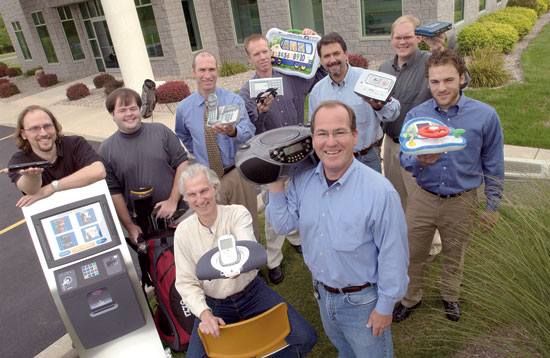Design firm is full of surprises—and grads
A. Sue Weisler
Shown with some of the products designed by KEK Associates are, from left: David Vogler ’97 (leaning on ticket kiosk); Tyler Porter ’04 (with golf bag); Craig Person ’80 (seated); Paul Klock ’90 (with telephone); Craig Hofmann ’92 (with toy on shoulder);
Gargoyles’ Ken Griffey Jr. flip-up sunglasses. Kodak EasyShare Printer Dock. GE Slimline telephone with caller ID. LeapFrog FLY Pentop Computer. A passenger rail car for the Boston T transit system. Swingline stapler. These diverse products have something in common: They were all designed at KEK Associates Inc., an industrial design and product development firm in Rochester. “People are surprised to find out how many products we have designed,” says Karl D. Kober ’80, ’82,’94 (electrical engineering, packaging science, MBA), president of KEK. “We develop about 100 new products a year.” The company has numerous ties to RIT. Located in a building next door to RIT’s Colony Manor Apartments, KEK employs 10 RIT graduates in the industrial design and engineering areas.
Several alums have started their careers at KEK and moved on to other parts of the country, including Scott Wilson ’91 (industrial design), who works for Nike (see www.rit.edu/magazine/winter2005). Several KEK employees also teach at RIT and the company has hosted numerous independent study programs. The firm hosts tours for students every year and often hires RIT students as industrial design interns and engineering co-ops. “It’s a great way for us to find new talent,” says Kober, who notes that the location of the company’s headquarters was selected in part because of its proximity to RIT.
KEK was founded as an industrial design firm in 1970 by Kober’s father, Karl E. Kober. After Karl D. graduated from RIT, he headed for Huntington Beach, Calif., and a job as an engineer at McDonnell Douglas. Eventually, his duties included recruiting trips to schools including RIT. “I was always impressed with the RIT students, who had professional experience and seemed to know what they wanted to do with their careers,” says Kober. “They really stood out compared to interviewees at other colleges.”
After five years with the aviation company, Kober opted to return to the family business. Since then, the company’s services have expanded to include mechanical engineering, animation and illustration, modeling and prototype, and sourcing as well as industrial design. Having all of this under one roof allows KEK to take clients from basic concept to working prototype as quickly as possible. “We have a saying, ‘Get physical fast’,” says Kober.
Technology has fueled KEK’s growth to great extent. When Kober joined the company, fax machines were unheard of and designers worked at drafting tables with pencil and paper. Today computers and the latest software allow designers and engineers to turn ideas into detailed images and quickly share them with clients via the Internet. The nature of industrial design has changed along with the technology, Kober says. “Forty years ago, the saying was ‘market makeable products vs. make marketable products.’ Today, for us, ‘user satisfaction’ is not even acceptable. We strive for user delight.” KEK clients range from large international corporations to small local companies.
The list includes Kodak, Bosch, Black & Decker, Fisher-Price, Hewlett-Packard, Chicago Pneumatic, and many others. Many have extensive internal product development resources. Why do they turn to an outside company such as KEK? “Large companies might come to us for smaller projects, or for projects that need to be done quickly, or for projects that are outside of the normal scope of what they do,” says Kober. “Smaller companies look for skills that they might not have in-house.” Work in progress at any given time could include point-of-sale touch-screen terminals for fast-food restaurants, a personal viewing device combining digital video eyewear and a pocket-sized media player, or a personal medical monitor with an Internet interface. “The great thing about working here,” says Craig Person ’80 (interior and industrial design), “is the variety.
We go from A to Z. Being bored is impossible.” To keep the creative juices flowing, employee break areas are supplied with video games, foosball, and other assorted toys. Brisk bouts of roller hockey also helps keep the ideas bubbling (Kober tried out for the hockey team his first two years at RIT and was the last man cut. He played JV hockey one year and varsity lacrosse one year). Kober says such amenities help make KEK a busy, productive, dynamic and fun workplace. That approach appears to be paying off. The company has won numerous industry honors for its work, including Business Week’s Industrial Design Excellence Award (IDEA) and Consumer Electronics Show Innovations Awards. “I think very few companies put all the pieces together at the level of excellence we do,” says Kober. “I’m very proud of what we’ve accomplished. Our people are amazing! Thanks, RIT.” Find out more at the KEK Design Website.
RIT grads at KEK RIT graduates currently working at KEK Associations are: Paul Klock ’90 (industrial design), manager, industrial design. Jeff Smith ’06 (industrial design), industrial designer. Jim Gresko ’85 (interior and industrial design), industrial designer. Craig Hofmann ’92 (industrial design), industrial designer. Tyler Porter ’04 (industrial design), industrial designer. David Vogler ’97 (mechanical engineering), mechanical engineer. Craig Peterson ’96 (mechanical engineering technology), mechanical engineer. Craig Person ’80 (interior and industrial design), mechanical designer. Mayra Monserrate Sylvestri ’88 (industrial design), industrial designer.













